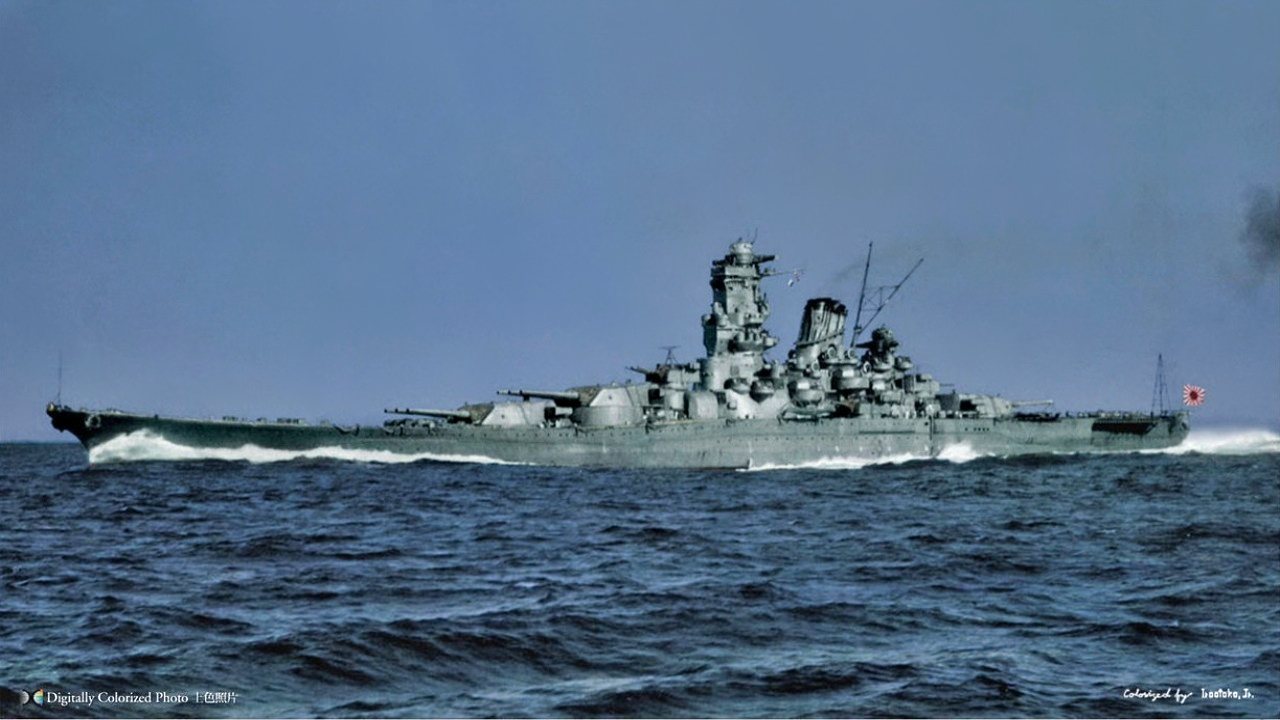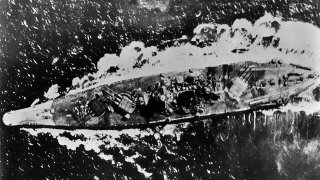The Incredible Story How Battleship Yamato (Biggest Ever) Was Destroyed
The Yamato class was the biggest battleship to ever sail. And how the IJN Yamato was destroyed during World War II is the stuff of legend.
What it Took to Destroy the Yamato Near Okinawa is Amazing - The 2019 film "The Great War of Archimedes" offers a highly fictionalized telling of the political maneuvers concerned with building the Imperial Japanese Navy's battleship Yamato. The movie helps highlight how the Yamato and her sister Musashi went on to carry such significant weight in Japanese culture.
The battleships represented the epitome of Imperial Japanese naval engineering, and because of their size, speed, and power, visibly embodied Japan's determination and readiness to defend its interests against the Western Powers and the United States in particular.
However, the film actually opens with the massive warship's destruction on April 7, 1945, when the Yamato was sunk by American carrier-based dive bombers and torpedo bombers with the loss of most of her crew.
Japan's Battleship Yamato: FAQs Answered and History
There remains a mystique about the Yamato, especially in Japan where it has been the subject of movies, and even a sci-fi series that sees the bloated battle wagon turned into a starship that saves humanity.
The Imperial Japanese Navy's Yamato – along with her sister ship Musashi – was the largest battleship ever constructed. her nine 46cm (18.1-inch) Type 94 main guns employed were the largest ever mounted on a battle wagon, and as a result, she was the most powerfully armed battleship ever constructed. Displacing nearly 72,000 tonnes at full load, she was simply massive.
Construction on the warship also was attended by great secrecy, which included the erection of high fences, protective roofing, and even camouflage netting. The United States Navy had no idea what they would face as the clouds of war appeared on the horizon. Yamato had been the pride of the Imperial Japanese Navy and it was from the bridge of the battleship in 1942 that Admiral Isoroku Yamamoto directed the fleet during the Battle of Midway.
It would be easy to suggest that Yamato was among the very best battleships ever constructed, but that is far from the case. Yamato could be considered hands down the absolute worst battleship ever built.
That is because warships need to be judged on what they did in service rather than what they could have done. She only directly engaged Allied warships on a single occasion, during the Battle off Samar – part of the larger Battle of Leyte Gulf – where she fired at several U.S. Navy warships.
Yamato sank just one American Casablanca-class escort carrier, the USS Gambier Bay (CVE-73), the only American carrier sunk by enemy surface gunfire during World War II; and reportedly one destroyer. It was a poor display of the capabilities of such an overhyped warship!
Japanese naval military doctrine still believed that essential to victory in a war would require being able to "out-gun" and "out-fight" its adversary, and it was expected that no ship could match the firepower and broadside weight of the Yamato-class. Yet, the massive guns had an unusually complex construction, which perhaps reflected the difficulty in manufacturing such a large caliber.
As was seen when the warship went into combat, the large guns weren't decisive weapons that could smash an enemy fleet. It also meant that Yamato and her sister ship needed to be supplied with specialized ammunition that wasn't employed by the IJN's other warships. Then there was the enormous cost of the warship
Yamato's poor service history is also due to the fact that the IJN was also reluctant to hazard Yamato without air cover, which limited how the vessel could be deployed. That also explains why the third vessel of the class was converted to a carrier while still under construction.
Simply put, Yamato was built for an age that was largely already over.
Time to Go for the Battleship Era
Yamato had set sail from Tokuyama in the Yamaguchi Prefecture of Japan just a day before she was sunk. In preparation for what was to be a suicide mission, codenamed "Operation Ten-Go," the mighty warship had taken on a full stock of ammunition yet carried only enough fuel for a one-way voyage to Okinawa.

The plan had been for the warship to beach itself and serve as an "unsinkable" gun emplacement and continue to fight until destroyed. Unfortunately for the Imperial Japanese Navy (IJN), the Allies had intercepted and decoded the radio transmission, learning of Operation Ten-Go. As United States Navy Admiral Raymond Spruance ordered six American battleships to prepare for surface action against Yamato, instead it was decided to strike the Japanese warship with carrier-based aircraft.
The first aircraft made contact with the Japanese Special Attack Force shortly after 0800 hours on April 7, 1945. An attack was launched a few hours later, and for hours the ship withstood wave after wave of assaults.
The U.S. forces were determined to sink Yamato, and from the first attack at 12:37 to the final crippling explosion at 14:23, the battleship was hit by at least 11 torpedoes and 6 bombs.
She sank rapidly, losing an estimated 3,055 of her 3,332 crew, including fleet commander Vice-Admiral Seiichi Itō. Though she was not the last battleship to be sunk during the war, as Yamato went to the bottom, the era of the big gun warships truly came to a close. The
Author Experience and Expertise
Peter Suciu is a Michigan-based writer. He has contributed to more than four dozen magazines, newspapers, and websites with over 3,200 published pieces over a twenty-year career in journalism. He regularly writes about military hardware, firearms history, cybersecurity, politics, and international affairs. Peter is also a Contributing Writer for Forbes and Clearance Jobs. You can follow him on Twitter: @PeterSuciu.


